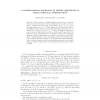Free Online Productivity Tools
i2Speak
i2Symbol
i2OCR
iTex2Img
iWeb2Print
iWeb2Shot
i2Type
iPdf2Split
iPdf2Merge
i2Bopomofo
i2Arabic
i2Style
i2Image
i2PDF
iLatex2Rtf
Sci2ools
DM
2011
2011
A combinatorial approach to height sequences in finite partially ordered sets
Fix an element x of a finite partially ordered set P on n elements. Then let hi(x) be the number of linear extensions of P in which x is in position i, counting from the bottom. The sequence {hi(x) : 1 ≤ i ≤ n} is the height sequence of x in P . In 1982, Stanley used the Alexandrov–Fenchel inequalities for mixed volumes to prove that this sequence is log-concave, i.e., hi(x)hi+2(x) ≤ h2 i+1(x) for 1 ≤ i ≤ n − 2. However, Stanley’s elegant proof does not seem to shed any light on the error term when the inequality is not tight; as a result, researchers have been unable to answer some challenging questions involving height sequences in posets. In this paper, we provide a purely combinatorial proof of two important special cases of Stanley’s theorem by applying Daykin’s inequality to an appropriately defined distributive lattice. As an end result, we prove a somewhat stronger result, one for which it may be possible to analyze the error terms when the log-concavity b...
| Added | 14 May 2011 |
| Updated | 14 May 2011 |
| Type | Journal |
| Year | 2011 |
| Where | DM |
| Authors | Csaba Biró, William T. Trotter |
Comments (0)

